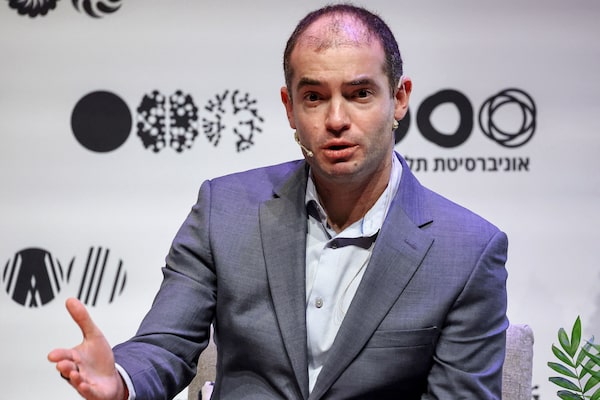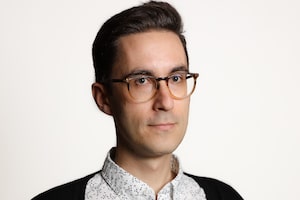
Ilya Sutskever, Russian Israeli-Canadian computer scientist and co-founder and Chief Scientist of OpenAI, speaks at Tel Aviv University in Tel Aviv on June 5.JACK GUEZ/Getty Images
Long before Ilya Sutskever moved to oust OpenAI chief executive Sam Altman, throwing the world’s most prominent artificial intelligence company into chaos and prompting nearly all of its 770 employees to threaten a mass resignation, he was a student at the University of Toronto, trying to coax a computer program to speak at a time when hardly anyone believed his approach had potential, if they knew about it at all.
Mr. Sutskever has played a prominent role in a series of AI breakthroughs over more than a decade, maintaining a low profile outside of his community of fellow researchers. But he is now a central figure in the drama at OpenAI. On Nov. 16, he texted Mr. Altman to invite him to a meeting the following day. When Mr. Altman hopped on the Google Meet call, Mr. Sutskever told him he was fired, according to an account from fellow OpenAI co-founder Greg Brockman. The company said that Mr. Altman “was not consistently candid in his communications.”
The board also punted Mr. Brockman from his role as chair, and he quit the company entirely the same day. The shocking coup kicked off days of turmoil. Microsoft Corp., which owns 49 per cent of OpenAI, has poached Mr. Altman and Mr. Brockman, and the rest of the company seems prepared to go with them.
Explainer: What’s happening at OpenAI? A look at Sam Altman’s firing and return as CEO
In a bizarre twist, Mr. Sutskever signed an open letter Monday demanding the remaining members of the OpenAI board – of which he is one – step down. “I deeply regret my participation in the board’s actions. I never intended to harm OpenAI,” he said on X, formerly known as Twitter. “I love everything we’ve built together and I will do everything I can to reunite the company.”
Mr. Sutskever did not reply to an e-mail from The Globe and Mail.
It was Mr. Altman who first reached out to him to discuss launching the venture that would become OpenAI. By then, Mr. Sutskever had a sterling reputation as a brilliant and dogged AI researcher. “He’s a visionary,” said Geoffrey Hinton, the emeritus U of T professor who is considered a legend in the field. “He’s very good at seeing what’s going to happen in the future.”
Mr. Sutskever was born in Russia but spent much of his early life in Israel. He first encountered a computer at age 5 and became entranced by the possibilities. He took up programming, and by the time his family moved to Canada when Mr. Sutskever was a teenager, he was already an accomplished coder. While only in Grade 11, he was admitted to a mathematics program at U of T in 2002, and eventually earned a PhD in computer science from the university in 2012.
“The field of AI back then when I was starting out was not a hopeful field,” he said on a podcast in 2021. “It was a field of desolation and despair. No one was making any progress at all.”
He knocked on Prof. Hinton’s door one day and said he was interested in working together on AI research. Prof. Hinton gave him a paper to read, and Mr. Sutskever came back to discuss it. “His immediate reaction to things were reactions that had taken experts in the field quite a long time to come up with,” he said.
Prof. Hinton had been researching an approach to machine learning involving neural networks for years, which have been likened to the human brain. Many experts considered it a dead end.
“We all were working on this new deep learning sort of field, which was not very popular,” said Ruslan Salakhutdinov, a computer science professor at Carnegie Mellon University who also completed his PhD under Prof. Hinton. “Out of all of us, Ilya was the biggest believer in neural networks.”
While at U of T, Mr. Sutskever developed a program could generate text characters based on an input – a primitive precursor to OpenAI’s ChatGPT. The tool, while no longer functional, is still online, described by Mr. Sutskever as “particularly amusing because it sometimes generates wise-sounding nonsense.”
A pivotal moment occurred in 2012. Along with fellow U of T grad student Alex Krizhevsky, he and Prof. Hinton entered the annual ImageNet competition. The tournament pitted algorithms against one another to see which one could most accurately detect and identify objects in picture. The one built by the U of T team, dubbed AlexNet, far surpassed its rivals, vindicating the team’s belief in neural networks, which soon dominated the field.
In 2013, Google purchased the trio’s startup, DNNresearch, for US$44-million. Mr. Sutskever joined Google as an AI researcher and contributed to the development of AlphaGo, a computer program that in 2016 defeated a professional human player in a game of Go, another AI milestone.
Chris Maddison, now an assistant computer science professor at U of T who was recruited for the AlphaGo project by Mr. Sutskever, said his former mentor had never wavered in his belief that “neural networks with lots of data, scaled up and together with obsessive engineering can create world-changing algorithms,” he said. “That vision was behind his push for AlphaGo.” It also seems to be behind the innovations at OpenAI, he added, including ChatGPT and text-to-image generator Dall-E.
In 2015, Mr. Sutskever was invited to a dinner by Mr. Altman, along with Elon Musk and Mr. Brockman, and their conversation led to the launch of OpenAI later that year. The goal was to pursue AI research for the benefit of humanity. In particular, they would focus on achieving artificial general intelligence, or AGI, which refers to systems that are as smart as, or smarter than, human beings.
While the concept itself is hotly debated, there was a divide among researchers about whether new methods were needed to achieve AGI or if existing approaches could be scaled up through bigger models and more data. “He was very much on team scale it up,” said Gillian Hadfield, a U of T law professor and former OpenAI policy adviser. “The fact that Yoshua Bengio and Geoffrey Hinton have stopped in their tracks this year and said, ‘Oh my God,’ is because of what sheer scale achieved, and that was Ilya,” she said.
Indeed, the risks of AGI have come to dominate Prof. Hinton’s own time of late. “He’s always thought it will come much sooner than I thought it would come,” he said of Mr. Sutskever. “But I’m beginning to believe him now.”
Mr. Sutskever’s fixation on AGI has been deepening for years. “He’s just obsessed with understanding your point of view on the development of artificial general intelligence and espousing his,” Prof. Maddison said. The two once met up after a conference in Barcelona, the first time seeing each other for at least a couple of years. Mr. Sutskever dispensed with small talk. “The first question that comes out of his mouth is like, ‘How long do you think until AGI shows up?’”
For years, OpenAI didn’t attract much notice outside of Silicon Valley and the broader AI research community, but it was achieving breakthroughs with text and image generation under Mr. Sutskever in his role as research director and later as chief science officer. It wasn’t until the launch of ChatGPT last November that the rest of the world caught up.
In recent months, Mr. Sutskever’s focus at OpenAI had become more esoteric. In July, he was announced as the co-lead of the company’s “superalignment” team. In the AI world, alignment refers to ensuring that AI models follow instructions correctly. Superalignment, in OpenAI’s view, goes further and refers to keeping AGI systems in check.
The announcement sketched out a plan in broad strokes, including allocating 20 per cent of OpenAI’s computing resources behind the effort. But for all of the foresight that Mr. Sutskever is said to possess, the one possibility the plan did not seem to contemplate was that the very people trying to ensure AI doesn’t turn rogue could themselves split apart.
 Joe Castaldo
Joe Castaldo Irene Galea
Irene Galea